Elevator pitch
Denmark is often highlighted as a “flexicurity” country characterized by lax employment protection legislation, generous unemployment insurance, and active labor market policies. Despite a sharp and prolonged decline in employment in the wake of the Great Recession, high job turnover and wage adjustments worked to prevent increased long-term and structural unemployment. Most unemployment spells were short, muting the effects on long-term and youth unemployment. Recent reforms boosted labor supply and employment, targeting the young, elderly, and immigrants. Employment recovered to its structural level around 2015 and has since increased due to a favorable business cycle situation and structural reforms (particularly increases in retirement age).
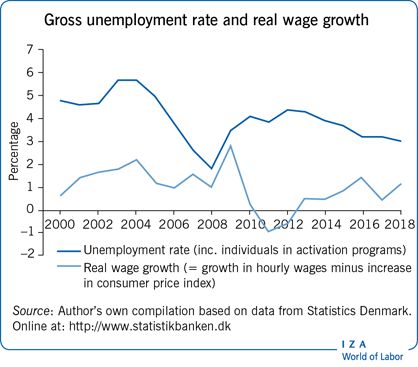
Key findings
Pros
Employment rates recovered after the crisis; employment has been increasing in recent years due to cyclical factors and structural reforms.
No significant increase has been observed in long-term unemployment and youth unemployment has remained relatively low.
High job turnover rates ensure that most unemployment spells are short, which helps prevent a rise in structural unemployment.
Wage adjustment has been flexible and wage competitiveness has recovered since the crisis.
There are few working poor due to high minimum wages and a compressed wage structure.
Cons
A large share of youths enters the labor market with low qualification levels; this is especially challenging because there are few low-skilled jobs.
Immigrants from low-income countries have low employment rates.
Job turnover may be excessively detrimental to human capital accumulation.
Wage inequality is moderately widening.
Average working hours are low.
Author's main message
Employment increased up to 2007–2008, then decreased sharply due to the financial crisis, and then increased again. The Danish economy was severely affected by the Great Recession, and the associated employment loss was large. Overall, the Danish “flexicurity” model was able to cope with the crisis. Although many have been affected by unemployment, unemployment spells have been short due to high job turnover rates. This has prevented a sharp increase in long-term unemployment and eased labor market entry for young people. Recent increases in employment have not induced large wage increases. Wage inequality is rising, but less than in other countries, and wage dispersion remains relatively low.
Motivation
The flexicurity model has been heralded for its ability to reconcile flexibility with social security. The key ingredients are lax employment protection legislation, a relatively generous social safety net, and active labor market policies. This model combines employers’ demand for flexibility with workers’ demand for income security, and maintains work incentives via the active labor market policy [1]. However, the flexicurity model is no guarantee against a recession, and the question is whether the model can cope with a large negative shock, remain flexible, and avoid persistent unemployment. The Danish experience shows that the answer is affirmative. A crucial aspect is the high job turnover rate, which has prevented long-term unemployment from increasing significantly. Global trends also affect the Danish labor market, and wage inequality has been rising, though it remains low. The financial viability of the flexicurity model—and the welfare state more generally—depends critically on maintaining a high employment rate. The social safety net has, in recent years, been overhauled to strengthen labor supply and employment, including reforms targeted at the elderly, the young, and immigrants. The main challenge calling for policy action is the low employment rate for immigrants, and the relatively large share of youth not obtaining a labor market relevant education.
Discussion of pros and cons
Denmark has been experiencing a boom-bust pattern. The period prior to the Great Recession had high growth, and unemployment fell below the structural level. There were clear signs of overheating with a booming housing market and accelerating wage increases. This was an unsustainable situation. Economic growth was already fading when the Great Recession set in, thus bringing the economy into a deep recession. The recovery has been slow, and employment did not reach its structural level until 2015, but has since been increasing.
The Great Recession had huge labor market impacts. Before the crisis, the employment rate was at a record high (Figure 1), but then plummeted rapidly, and the recovery has been slow. The labor market was thus harder hit and recovered more slowly than in many other countries. Unemployment increased by 2.5 percentage points between 2008 and 2009, and 4 percentage points between 2008 and 2010, almost double the increase for OECD countries on average, although unemployment remained below the OECD average. The subsequent increase in employment has been smooth and not ignited high wage increases.
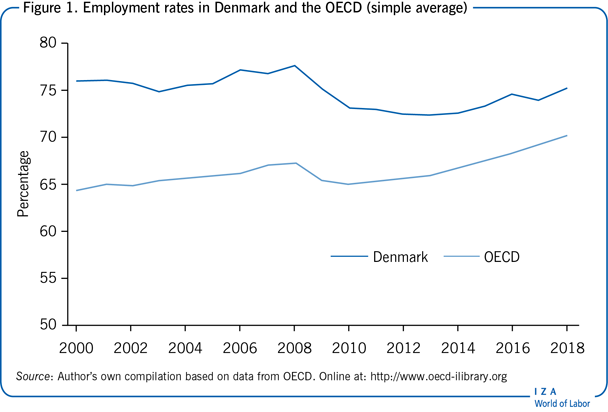
The Danish flexicurity labor market has received considerable attention in recent years, especially for its ability to make a relatively generous social safety net compatible with a high employment rate [1]. The Great Recession brought the model a serious test. While the model is no guarantee against business cycle fluctuations, the interesting question is how the model performs in a severe recession. Lax firing rules make it likely that employment will fall drastically when aggregate demand drops, and although the social safety net provides a cushion against large income losses for the unemployed, the financial viability of the model is at risk if structural employment decreases. A prolonged decline in employment reduces tax revenues and increases social expenditures, thus putting public finances under strain.
High turnover rates have benefited Denmark's labor market
A key property of the flexicurity model is a high level of job turnover, implying that the unemployed (as well as youths entering the labor market) can find jobs fairly easily, and that most unemployment spells are short. Indeed, the data bear this out, as the general level of job inflows and outflows is high. Although job inflows plummeted as a consequence of the crisis, they soon recovered, and the gross in- and outflow rates quickly returned to pre-crisis levels or even higher (Figure 2).
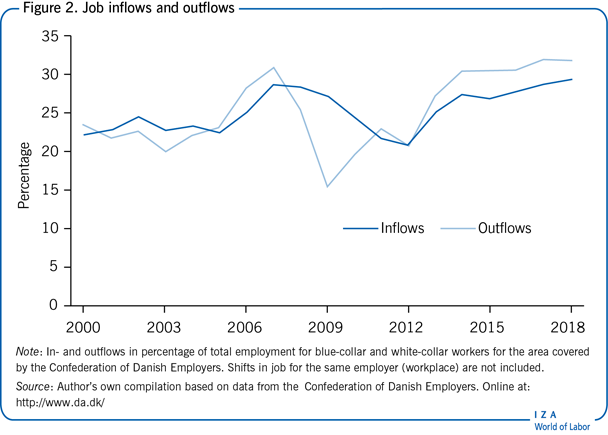
Two additional facts are worth mentioning here. First, in the midst of the crisis, exit rates from unemployment were not significantly lower than during the boom years beforehand. Accordingly, most unemployment spells were short. In Figure 3, the survival function for the unemployed (showing how many unemployed stay unemployed after a given number of weeks) is shown for four different years: 2004, 2007, 2013, and 2017. As expected, the survival function is lowest in 2007 when the economy was booming. More interesting is the fact that already in 2013 (and about the same in 2017), the survival function was similar to that for 2004, a year most business cycle experts consider close to neutral; that is, the unemployment rate was at the structural level. While unemployment increased during the recession, unemployment spells remained rather short. The average duration of an unemployment spell among those on unemployment benefits was 17 weeks in 2014 (compared to about 13 weeks during the boom period). Importantly, exits from unemployment into employment since 2014 are also back at pre-crisis levels. Hence, while many have been affected by unemployment, most unemployment spells are rather short (in 2013, close to 50% of total unemployment was made up of spells of less than three months).
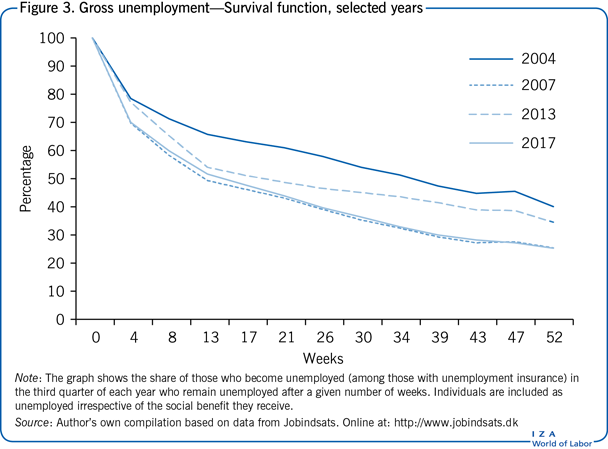
This high level of turnover in the labor market is also the driving force behind Denmark's comparably low levels of youth and long-term unemployment. Both are about half the EU average, during the crisis years and at other times too. High turnover rates thus effectively work as an implicit work-sharing mechanism. Equal burden sharing is important from a distributional perspective, but it is also of structural importance. The alternative would be longer unemployment spells concentrated among a smaller group of individuals, more long-term unemployed and a corresponding depreciation of human and social capital. In short, the high turnover rates reduce the negative structural potential of high unemployment.
A possible downside of the high job turnover rate is that it may be detrimental to firm-specific worker training. The high turnover rate makes it difficult for firms to protect investments in their workers’ human capital, if the training is of relevance in other firms. This may lead to a suboptimal level of investment in human capital with negative effects on productivity growth.
Flexible wages facilitate labor market adjustments
Wage developments reflect the boom-bust pattern. When employment increased and unemployment decreased, wage increases (both nominal and real) picked up and wage competitiveness (relative unit labor costs) deteriorated by about 15% over the period 2004–2009. The crisis reversed these wage developments, inducing negative real wage growth, which, in turn, led to a recovery of wage competitiveness (Illustration). Wage flexibility—both upward and downward—has thus been relatively high by international comparison, and sluggish wage adjustment is thus not the main reason for the slow recovery of employment. This differs from earlier periods, and can partly be attributed to a move from a highly centralized wage-setting system toward a model of so-called “centralized decentralization.” Collective arrangements retain their role as regulators of labor market conditions, while wage determination has become more decentralized [2]. The recent increase in employment has increased real wages, but only moderately.
As in most OECD countries, wage inequality has followed an upward trend (Figure 4), though wage dispersion remains low by international comparison. There are few working poor, and the number increased little during the crisis. It is noteworthy that the wage share (wages as a share of value added) has remained fairly stable for decades, and there has not been a shift between labor and capital income, as experienced in many other countries.
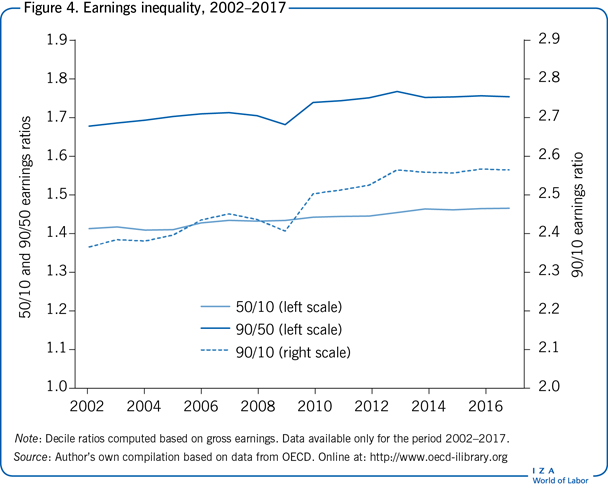
High employment rates and the large share of the population receiving transfers
The labor market situation can be assessed from two angles: one is the share of the working-age population in employment (Figure 1), and the other is the share receiving some form of public income support. The employment rate in Denmark is high by international standards, but so is the share of the working-age population receiving public transfers. The latter reflects more extended welfare arrangements, implying that most who are unable to support themselves are entitled to some form of public support. It is an immediate corollary that public finances are very sensitive to the employment rate; higher employment increases tax revenues and reduces social expenditures, and vice versa. In recent years there has been much focus on reducing the share of the working-age population receiving social transfers. All types of social transfers have been overhauled in an attempt to strengthen labor supply and employment. These changes comprise both eligibility criteria and conditions as well as benefit levels. Several aspects of these changes are of particular interest, most notable when it comes to youths, the elderly, and immigrants.
Youths
The share of youth neither in employment, education, nor training (NEET) in Denmark is below the OECD average, but it has been on an upward trend. While much has been said about the Danish flexicurity model's ability to attain a low unemployment rate, the issue of youth entering the labor market with weak qualifications is a challenge [3].
The share of cohorts without education relevant for the labor market is a particular challenge. A key welfare state objective is to reconcile high employment with decent wages (i.e. no working poor). The wage structure is compressed and minimum wages are high by international comparison, thus creating a situation in which the qualifications required to find jobs are also high. This is important for maintaining a relatively equal distribution of income, but it is also a precondition for the financial viability of the welfare model.
The social safety net has recently been reformed to strengthen the incentive for all youths to acquire relevant qualifications. For individuals below the age of 30 (before 2015: 25 years) not having an education yielding labor market qualifications, the social assistance benefit level has been reduced, such that it does not provide better compensation than study grants. Eligibility for support requires commencing education, or, alternatively, participating in an activation program.
These changes are aimed at reducing the number of NEETs. The experience so far is mixed. On the one hand, some evidence points to positive effects on employment and, in particular, on enrollment in education among the targeted groups. On the other hand, there is no noticeable decline in the share of youth depending on social benefits.
It is premature to draw conclusions about the full effect of the reform, since it requires not only that youths commence an education but also that they complete it successfully. One criticism of the reform is that educational deficiencies should be targeted much earlier than when people are above the age of 20. Most people in the target groups have been enrolled in education before—without completing it—which points to the importance of early intervention (primary school or earlier) as a more effective tool in overcoming educational barriers.
The unemployment insurance scheme has also been reformed, affecting everyone in the labor market. Most important is a reduction in the maximum benefit duration from four to two years. Since this reform was implemented during the crisis, it has been very controversial. The reform also strengthened incentives to accept short-term jobs.
Elderly
While the overall employment rate is high, it has in the past been low for age groups above 55. This has changed in recent years, even during the recession years. A number of reforms have tightened possibilities for early retirement and increased the pension age (further changes are still being phased in), and it will eventually be indexed to longevity. These changes have been motivated by increasing longevity and healthy aging as well as the need to ensure fiscal sustainability by increasing the relative share of a lifetime that people are working and thus contributing to the welfare state. One of the arguments against these changes has been that the job possibilities for the elderly are few. In a business cycle perspective, elderly workers are not more exposed to unemployment risk than young cohorts, but they may have a hard time returning to jobs. However, that does not preclude a high structural employment rate for the elderly, which was true in Denmark even during the crisis years. The employment rate for the 60–64 age group has increased greatly, from 47% for men and 28% for women in 2008, to 68% and 53% respectively in 2018.
Immigration
Employment rates for immigrants vary considerably depending on an individual's reasons for immigrating (study, work, refugee, or family unification) and country of origin [4]. Employment rates for immigrants from low-income countries (mostly refugees and family unifications) can be viewed in two ways, by comparing either levels or gaps relative to other OECD countries, as in Figure 5. The level of employment of such immigrants is not much different from the OECD average. The gap—that is, the difference in the employment rate relative to natives—however, is large, especially for women. This reflects, of course, that employment rates are high in Denmark, so that it is more difficult for immigrant employment to reach this level.
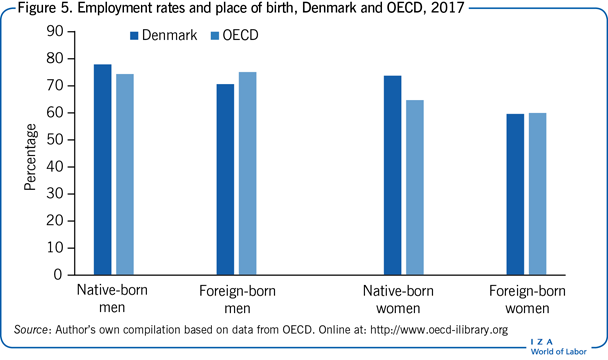
Differences in employment rates between natives and immigrants may have numerous explanations. An interesting question is whether the design of the welfare model is an impediment to labor market entry for some immigrants. As noted, the Danish labor market is characterized by relatively high minimum wages and a compressed wage structure, which ensures that no full-time employed fall below the poverty line. As a consequence, the qualifications required to find a job are relatively high, and low-skilled jobs are in short supply. Different cultures and norms for some immigrants with respect to gender roles may also play a part, especially for female employment. These effects may be compounded by language barriers, problems related to recognizing foreign educational qualifications, and possibly discrimination in the labor market.
The policy debate on immigration has been intense in Denmark, and various policy initiatives have been undertaken, including the tightening of immigration rules. Moreover, some changes in the social safety net have been prompted by immigration issues. The ultimate floor in the social safety net is the so-called social assistance, which provides economic support to those unable to support themselves and their family. A residence principle for eligibility was introduced in 2002, implying that eligibility for social assistance requires residence in Denmark for seven out of the last eight years (starting in 2019, nine of the previous ten years). In 2006, this was further strengthened by adding an employment criterion requiring ordinary employment for an accumulated period of at least two and a half years within the last eight. (A further employment criterion was added to target couples, implying lower levels of social assistance to couples with an insufficient employment record.) Individuals not fulfilling these requirements are entitled to a different transfer (start aid/introduction benefit), equivalent to roughly half the value of social assistance. While these conditions have affected some Danes returning home after extended periods abroad, they have had the largest effect on groups of immigrants with low employment rates, who were very likely to receive social assistance before the changes. These initiatives have been debated heatedly. They were introduced in 2002, abolished in 2012, and reintroduced in 2015 (and strengthened in 2019). The frequent policy changes reflect the sensitivity of the issue and the divided political views. However, the trend in recent years has been toward a tightening of the rules on both immigration and access to the social safety net.
Limitations and gaps
Denmark has recently implemented a number of reforms intended to address issues related to youth labor market participation and immigration. However, it is too early to assess their effects. In particular, it is unclear whether changes in the social safety net will succeed in increasing the educational level of youth, thereby raising their employment rate, or how reforms to social assistance eligibility will impact immigrants.
Although employment rates are high, average working hours are low due to the prevalence of part-time work. It is easier to regulate labor market participation (the extensive margin) via entitlement conditions than it is to regulate working hours (the intensive margin). However, hours restrictions have been included in the entitlement conditions for social benefits, and tax reforms have been implemented to target working hours.
Summary and policy advice
The Danish experience shows that even a deep crisis was not enough to prevent the flexicurity model from working. Despite recent global and national challenges, the balance between flexibility and security has been retained. The model's financial viability ultimately rests on maintaining a high employment level; even during the crisis, Denmark succeeded in launching forward-looking reforms to support high labor supply and employment. This is essential for maintaining the financial balance of the model.
However, challenges remain. Ensuring that a high employment rate coexists with relatively low wage dispersion is difficult, particularly considering the problems arising from youths and immigrants entering the labor market with weak qualifications. Policymakers are working to address these issues via changes in the social safety net and education programs, although it is too soon to say whether their efforts will bear fruit. Since most youth do enroll in upper-secondary, post-secondary non-tertiary, or tertiary education, the main challenge is to increase completion rates, and earlier intervention may be called for to ensure that the educational objectives can be reached.
Acknowledgments
The author thanks an anonymous referee and the IZA World of Labor editors for many helpful suggestions on earlier drafts. Previous work of the author contains a larger number of background references for the material presented here and has been used intensively in all major parts of this article: Andersen, T. M. “A flexicurity labor market during recession.” IZA World of Labor (2015): 173; Andersen, T. M. Labour Market Policies in Denmark. Background Paper to Norwegian Government Commission on Employment Policies, 2019. Version 2 of the article updates the content and figures to 2018.
Competing interests
The IZA World of Labor project is committed to the IZA Code of Conduct. The author declares to have observed the principles outlined in the code.
© Torben M. Andersen